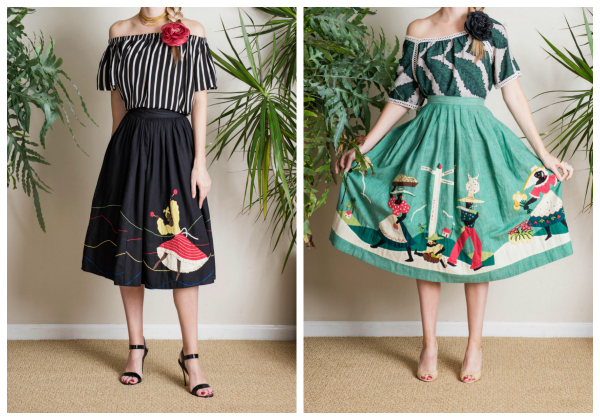It's late on a Thursday night, and I've just spent a good three hours trying to track down information about Dorothy McNab, the designer of the vintage skirts above. I'm Ryan Gosling as K in Blade Runner 2049, and I know that if I keep looking, the internet will give up its secrets.
(Did you realize you have to pay a hefty fee to search the archives of old newspapers? Shouldn't that be public domain?)
The story of the designer of these skirts shall be revealed soon. But first, let's get to the owner of them.
The skirts belong to my neighbor friend Melody. She has held onto them forever because they're loaded with nostalgic memories. They belonged to her grandmother, Violet VanDoren Eliason. ('Violet' as a girl's name needs to be revived.)
But Melody has reached that point in her life -- you know the one I'm talking about -- where she is alert to the realization that she has too much stuff. Vowing not to burden her son with generations worth of detritus, she is going through that arduous and emotional process of thinning her things.
Melody knows that I'm a lover of old textiles, and she called me about these skirts. "They're appliquéd and embroidered with little Jamaican scenes," she said. "Really quite charming."
Nothing entices me more than the word 'charming.'
And aren't they though?
For shopping information on this skirt, click here.
I asked Melody for the story behind these Jamaican skirts and here is what she wrote:
In 1957, I visited Jamaica with my parents and grandparents. It was five years away from independence and still a British colony. My guess is this was quite a chic destination at the time, as Prince Philip and Queen Elizabeth visited as well as the jet set of the 1950s, Truman Capote, Peter O’Toole, and Sophia Loren. Ian Fleming, Nöel Coward and Errol Flynn had homes in Jamaica. It was a tourist destination with outdoor markets full of straw purses, handmade maracas and embroidered clothing, As a 7-year-old, I was only interested in the swimming pool, diving for pennies and the adoration of my grandparents.
But, still, as my mother first and, then, my grandmother passed away, I held on to the souvenirs from this 1957 vacation and moved them from Seattle to Washington, DC. to Milwaukee. Sixty summers later, I still wear the delicate, linen, hand-embroidered blouse purchased by “Nana” in Jamaica.
But my waistline has long ago outgrown the charming hand-appliqued skirts, but I JUST couldn’t give them away. The scenes of young boys tending goats or young women selling fruit were just too charming to give up. Maybe I’ll frame them? Perfect for pillows? Ugh. I have to let go. I cannot be a “keeper” any longer.
Violet VanDoren Eliason, Melody's grandmother, wearing white eyelet trimmed with black grosgrain ribbon, dangly earrings, an armful of bangles, and a beautiful smile. She had style!
At this point, Melody was sorting through boxes of old reel-to-reel films when lo and behold, she found footage of Violet coming out of a dress shop with the green skirt. You can watch the clip yourself. Melody's technique for sharing this was pretty lo-fi. She used her iPhone to videotape while her husband manned the camera.
She found lots of interesting footage from her grandparents' trip in 1957. In Melody's words, "I realized I visited Jamaica at a remarkable time in history." Here is more of her account:
It wasn’t slavery, but there was still what seemed to be “pressed labor” at the Jamaican boat docks in 1957. I remember a black overseer with a whip as he supervised the loading of bananas onto the boats. In 1956, Harry Belafonte released “Day-O, The Banana Boat Song,” a traditional Jamaican folk song or work song from the point of view of dock workers working the night shift loading bananas onto ships. Daylight has come, the shift is over, and they want their work to be counted so that they can go home.
I remember this all so well because there was a young girl about my age standing on the docks as the rows and rows of men loaded the bananas. We were curious about each other. I remember my grandfather giving me a penny to give to the little girl as a gesture of friendship. The man with the whip saw and, perhaps, assumed the little girl was begging and the whip slammed on the pavement in her direction. Did he hit the little girl? I think he did. I didn’t understand. I felt so helpless and wanted to explain how sorry I was and I didn’t mean to cause my new friend any harm, but I was hurried away, as we were all so shocked by the unexpected violence.
On a happier note, I, also, have vivid memories of driving across the island from Montego Bay to Kingston, Jamaica. I think it must have been a Sunday afternoon. Every village, it seemed, had people dancing in the streets.This music was called “calypso” by my parents and grandparents, but it really was Ska, a musical style that originated in Jamaica in the late 1950s and was the precursor to reggae. This was the beginning of Jamaica’s “street dance” history, which I was able to experience first hand.
Fifty years later, it was my son who re-introduced me to ska and what was to become reggae, and made me appreciate in my adult life the music of Bob Marley. Our son J.B. made me realize what an incredible introduction I had to this music in my young childhood, and how lucky I was to hear the songs of freedom that were being sung from the boat docks to the capital of Kingston in 1957.
So.... on the designer, Dorothy McNab, this is what Melody discovered:
"Australian born Dorothy McNab was a well known designer based in Montego Bay, Jamaica. Her designs started appearing in the mid 1950s and lasted to the end of the 1960s. A Jamaican newspaper reported in 1955 that during Princess Margaret's Jamaican tour, her more informal clothes would be pure silks and nylons hand- printed, designed by Dorothy MacNab of Montego Bay. Each one is printed with an exotic West Indian leaf pattern. A 1963 article in the Miami Herald reported that 'Dorothy McNab's styles were worn all over the world. Definitely a romantic at heart, Mrs. McNab designs clothes that emphasize femininity."
Also, this:
"Two of her silk pieces can be found today in the Metropolitan Museum of Art and in the Indianapolis Museum of Art."
In searching for a photo of Dorothy McNab, I discovered that egads! she is the sister of the famously flamboyant and wildly successful interior designer Rose Cumming. Also, young Dorothy was a silent film actress in the 1920s and 30s. She appeared in 39 films and was directed by Cecil B. DeMille. Her connections to the Hollywood set certainly helped her sister land some top drawer clients like Mary Pickford, Marlene Dietrich, and Gloria Swanson.
(You can read more about Rose Cumming here, but there is practically nothing on poor Dorothy. I'm going to be updating the Wikipedia page for Dorothy Cumming tonight.)
Dorothy, Rose, and her third sister, Eileen, emigrated to the U.S. from New South Wales where her family ran a cattle station. Her parents furnished the place by purchasing the entire contents of a colonial governor's mansion. One can only imagine ebonized beds, carved sideboards, rattan chairs, tribal rugs, and truckloads of ancestral silver.
Dorothy had two marriages. Her second marriage to artist Allan McNab also increased her connections. He was the art director at Life Magazine. Between her Hollywood friends, her ties to media, her sister's upper crust clientele, and her talent, she couldn't lose. She ended up opening two dress shops -- one in Montego Bay on the water and another in Ocho Rios. She also sold her designs to Neiman-Marcus.
Even after she eventually stopped designing clothing, she and her sister collaborated together, designing wallpapers and fabrics that are still in use today. Here is a vintage chair covered in one of their collaborations.
Dorothy and Rose led colorful lives. So did Violet and Violet's granddaughter, Melody. I love being in Melody's home. It is absolutely full of art and antiquities that she has amassed on her world travels. She is most at home in Africa.
I could go on and on about these four women but this is about trying to sell skirts. We shall see who in the online shopping world will be captivated by the inherent mystery, fun, and adventure that is stitched into the panels of these lovely pieces. Who says we can't live forever? Dorothy's imprint is mixed with Violet's is mixed with Melody's and will soon be mixed with someone else's.
Melody styling her grandmother Violet's skirt in my basement studio. Photo by Renn Kuhnen.
For shopping information, click on each photo:
Photos of vintage Dorothy McNab skirts by Renn Kuhnen.










